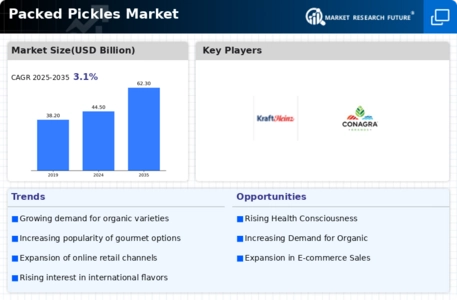The Packed Pickles Market is currently characterized by a dynamic competitive landscape, driven by evolving consumer preferences and a growing inclination towards convenience foods. Key players such as Vlasics (US), B&G Foods (US), and Mt. Olive Pickle Company (US) are strategically positioning themselves through innovation and regional expansion. Vlasics (US), for instance, has focused on enhancing its product line with organic and health-oriented options, appealing to health-conscious consumers. Meanwhile, B&G Foods (US) has been actively pursuing acquisitions to broaden its portfolio, thereby increasing its market share and diversifying its offerings. These strategies collectively contribute to a moderately fragmented market structure, where competition is intensifying as companies seek to differentiate themselves through unique product offerings and enhanced consumer engagement.
In terms of business tactics, companies are increasingly localizing manufacturing to reduce supply chain vulnerabilities and optimize logistics. This approach not only enhances operational efficiency but also allows for quicker response times to market demands. The competitive structure of the Packed Pickles Market remains moderately fragmented, with several key players exerting influence over pricing and product availability. The collective actions of these companies indicate a trend towards consolidation, as they seek to leverage economies of scale while maintaining a focus on quality and innovation.
In August 2025, Grillo's Pickles (US) announced a partnership with a local organic farm to source cucumbers, emphasizing its commitment to sustainability and local sourcing. This strategic move not only enhances the brand's image but also aligns with the growing consumer demand for transparency in food sourcing. By integrating local agricultural practices, Grillo's Pickles (US) is likely to strengthen its market position and appeal to environmentally conscious consumers.
In September 2025, Kraft Heinz (US) launched a new line of pickles infused with exotic flavors, targeting the adventurous palate of younger consumers. This innovation reflects a broader trend within the industry, where flavor experimentation is becoming a key differentiator. By diversifying its product offerings, Kraft Heinz (US) aims to capture a larger share of the market, particularly among millennials and Gen Z consumers who are increasingly seeking unique culinary experiences.
Moreover, in July 2025, Hengstenberg (DE) expanded its distribution network in Asia, aiming to tap into the growing demand for pickled products in emerging markets. This strategic expansion not only enhances Hengstenberg's global footprint but also positions the company to capitalize on the rising popularity of pickled foods in diverse culinary traditions. Such moves indicate a proactive approach to market penetration and consumer engagement in regions with untapped potential.
As of October 2025, the competitive trends within the Packed Pickles Market are increasingly defined by digitalization, sustainability, and the integration of artificial intelligence in supply chain management. Strategic alliances are becoming more prevalent, as companies recognize the value of collaboration in enhancing product offerings and market reach. Looking ahead, competitive differentiation is likely to evolve from traditional price-based competition towards a focus on innovation, technological advancements, and supply chain reliability. This shift underscores the importance of agility and responsiveness in meeting the changing demands of consumers.













Leave a Comment